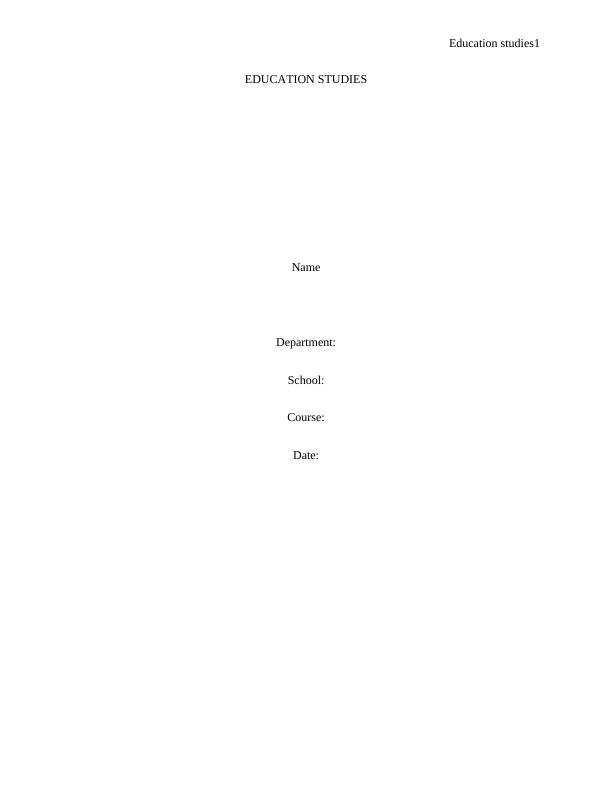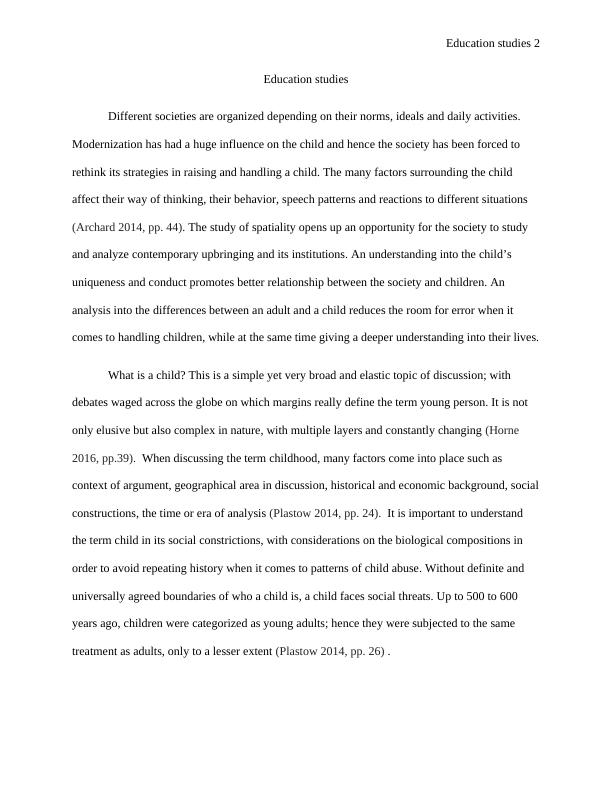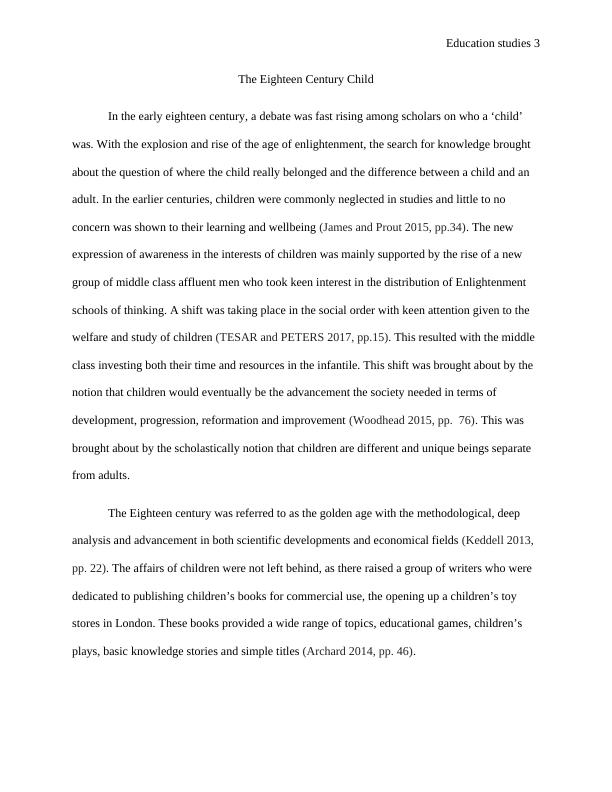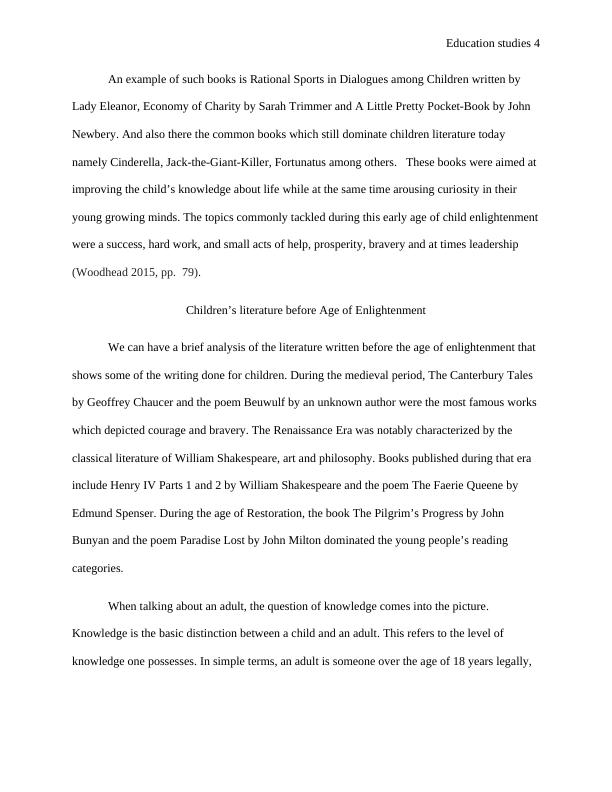Understanding Childhood: A Study of Child Development and Education
Added on 2023-06-12
16 Pages4520 Words146 Views
Education studies1
EDUCATION STUDIES
Name
Department:
School:
Course:
Date:
EDUCATION STUDIES
Name
Department:
School:
Course:
Date:

Education studies 2
Education studies
Different societies are organized depending on their norms, ideals and daily activities.
Modernization has had a huge influence on the child and hence the society has been forced to
rethink its strategies in raising and handling a child. The many factors surrounding the child
affect their way of thinking, their behavior, speech patterns and reactions to different situations
(Archard 2014, pp. 44). The study of spatiality opens up an opportunity for the society to study
and analyze contemporary upbringing and its institutions. An understanding into the child’s
uniqueness and conduct promotes better relationship between the society and children. An
analysis into the differences between an adult and a child reduces the room for error when it
comes to handling children, while at the same time giving a deeper understanding into their lives.
What is a child? This is a simple yet very broad and elastic topic of discussion; with
debates waged across the globe on which margins really define the term young person. It is not
only elusive but also complex in nature, with multiple layers and constantly changing (Horne
2016, pp.39). When discussing the term childhood, many factors come into place such as
context of argument, geographical area in discussion, historical and economic background, social
constructions, the time or era of analysis (Plastow 2014, pp. 24). It is important to understand
the term child in its social constrictions, with considerations on the biological compositions in
order to avoid repeating history when it comes to patterns of child abuse. Without definite and
universally agreed boundaries of who a child is, a child faces social threats. Up to 500 to 600
years ago, children were categorized as young adults; hence they were subjected to the same
treatment as adults, only to a lesser extent (Plastow 2014, pp. 26) .
Education studies
Different societies are organized depending on their norms, ideals and daily activities.
Modernization has had a huge influence on the child and hence the society has been forced to
rethink its strategies in raising and handling a child. The many factors surrounding the child
affect their way of thinking, their behavior, speech patterns and reactions to different situations
(Archard 2014, pp. 44). The study of spatiality opens up an opportunity for the society to study
and analyze contemporary upbringing and its institutions. An understanding into the child’s
uniqueness and conduct promotes better relationship between the society and children. An
analysis into the differences between an adult and a child reduces the room for error when it
comes to handling children, while at the same time giving a deeper understanding into their lives.
What is a child? This is a simple yet very broad and elastic topic of discussion; with
debates waged across the globe on which margins really define the term young person. It is not
only elusive but also complex in nature, with multiple layers and constantly changing (Horne
2016, pp.39). When discussing the term childhood, many factors come into place such as
context of argument, geographical area in discussion, historical and economic background, social
constructions, the time or era of analysis (Plastow 2014, pp. 24). It is important to understand
the term child in its social constrictions, with considerations on the biological compositions in
order to avoid repeating history when it comes to patterns of child abuse. Without definite and
universally agreed boundaries of who a child is, a child faces social threats. Up to 500 to 600
years ago, children were categorized as young adults; hence they were subjected to the same
treatment as adults, only to a lesser extent (Plastow 2014, pp. 26) .

Education studies 3
The Eighteen Century Child
In the early eighteen century, a debate was fast rising among scholars on who a ‘child’
was. With the explosion and rise of the age of enlightenment, the search for knowledge brought
about the question of where the child really belonged and the difference between a child and an
adult. In the earlier centuries, children were commonly neglected in studies and little to no
concern was shown to their learning and wellbeing (James and Prout 2015, pp.34). The new
expression of awareness in the interests of children was mainly supported by the rise of a new
group of middle class affluent men who took keen interest in the distribution of Enlightenment
schools of thinking. A shift was taking place in the social order with keen attention given to the
welfare and study of children (TESAR and PETERS 2017, pp.15). This resulted with the middle
class investing both their time and resources in the infantile. This shift was brought about by the
notion that children would eventually be the advancement the society needed in terms of
development, progression, reformation and improvement (Woodhead 2015, pp. 76). This was
brought about by the scholastically notion that children are different and unique beings separate
from adults.
The Eighteen century was referred to as the golden age with the methodological, deep
analysis and advancement in both scientific developments and economical fields (Keddell 2013,
pp. 22). The affairs of children were not left behind, as there raised a group of writers who were
dedicated to publishing children’s books for commercial use, the opening up a children’s toy
stores in London. These books provided a wide range of topics, educational games, children’s
plays, basic knowledge stories and simple titles (Archard 2014, pp. 46).
The Eighteen Century Child
In the early eighteen century, a debate was fast rising among scholars on who a ‘child’
was. With the explosion and rise of the age of enlightenment, the search for knowledge brought
about the question of where the child really belonged and the difference between a child and an
adult. In the earlier centuries, children were commonly neglected in studies and little to no
concern was shown to their learning and wellbeing (James and Prout 2015, pp.34). The new
expression of awareness in the interests of children was mainly supported by the rise of a new
group of middle class affluent men who took keen interest in the distribution of Enlightenment
schools of thinking. A shift was taking place in the social order with keen attention given to the
welfare and study of children (TESAR and PETERS 2017, pp.15). This resulted with the middle
class investing both their time and resources in the infantile. This shift was brought about by the
notion that children would eventually be the advancement the society needed in terms of
development, progression, reformation and improvement (Woodhead 2015, pp. 76). This was
brought about by the scholastically notion that children are different and unique beings separate
from adults.
The Eighteen century was referred to as the golden age with the methodological, deep
analysis and advancement in both scientific developments and economical fields (Keddell 2013,
pp. 22). The affairs of children were not left behind, as there raised a group of writers who were
dedicated to publishing children’s books for commercial use, the opening up a children’s toy
stores in London. These books provided a wide range of topics, educational games, children’s
plays, basic knowledge stories and simple titles (Archard 2014, pp. 46).

Education studies 4
An example of such books is Rational Sports in Dialogues among Children written by
Lady Eleanor, Economy of Charity by Sarah Trimmer and A Little Pretty Pocket-Book by John
Newbery. And also there the common books which still dominate children literature today
namely Cinderella, Jack-the-Giant-Killer, Fortunatus among others. These books were aimed at
improving the child’s knowledge about life while at the same time arousing curiosity in their
young growing minds. The topics commonly tackled during this early age of child enlightenment
were a success, hard work, and small acts of help, prosperity, bravery and at times leadership
(Woodhead 2015, pp. 79).
Children’s literature before Age of Enlightenment
We can have a brief analysis of the literature written before the age of enlightenment that
shows some of the writing done for children. During the medieval period, The Canterbury Tales
by Geoffrey Chaucer and the poem Beuwulf by an unknown author were the most famous works
which depicted courage and bravery. The Renaissance Era was notably characterized by the
classical literature of William Shakespeare, art and philosophy. Books published during that era
include Henry IV Parts 1 and 2 by William Shakespeare and the poem The Faerie Queene by
Edmund Spenser. During the age of Restoration, the book The Pilgrim’s Progress by John
Bunyan and the poem Paradise Lost by John Milton dominated the young people’s reading
categories.
When talking about an adult, the question of knowledge comes into the picture.
Knowledge is the basic distinction between a child and an adult. This refers to the level of
knowledge one possesses. In simple terms, an adult is someone over the age of 18 years legally,
An example of such books is Rational Sports in Dialogues among Children written by
Lady Eleanor, Economy of Charity by Sarah Trimmer and A Little Pretty Pocket-Book by John
Newbery. And also there the common books which still dominate children literature today
namely Cinderella, Jack-the-Giant-Killer, Fortunatus among others. These books were aimed at
improving the child’s knowledge about life while at the same time arousing curiosity in their
young growing minds. The topics commonly tackled during this early age of child enlightenment
were a success, hard work, and small acts of help, prosperity, bravery and at times leadership
(Woodhead 2015, pp. 79).
Children’s literature before Age of Enlightenment
We can have a brief analysis of the literature written before the age of enlightenment that
shows some of the writing done for children. During the medieval period, The Canterbury Tales
by Geoffrey Chaucer and the poem Beuwulf by an unknown author were the most famous works
which depicted courage and bravery. The Renaissance Era was notably characterized by the
classical literature of William Shakespeare, art and philosophy. Books published during that era
include Henry IV Parts 1 and 2 by William Shakespeare and the poem The Faerie Queene by
Edmund Spenser. During the age of Restoration, the book The Pilgrim’s Progress by John
Bunyan and the poem Paradise Lost by John Milton dominated the young people’s reading
categories.
When talking about an adult, the question of knowledge comes into the picture.
Knowledge is the basic distinction between a child and an adult. This refers to the level of
knowledge one possesses. In simple terms, an adult is someone over the age of 18 years legally,

End of preview
Want to access all the pages? Upload your documents or become a member.
Related Documents
Discourses about Childhood: Enlightenment's Separation of Children from Adultslg...
|11
|3424
|440
The Constructivist vs. Critical Theory Paradigm in Child Developmentlg...
|8
|1833
|169
Understanding Children’s Worlds: Historical Development, Contemporary Discourses, and Impact on Societylg...
|9
|2686
|203
International Rural Contexts: Youth Outmigration and Educationlg...
|4
|784
|329
Impact of Divorce on Family, Child and Childcare Settinglg...
|5
|983
|307
Sport Facility and Management Assignmentlg...
|8
|2026
|252
